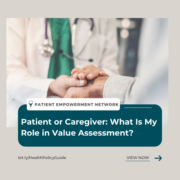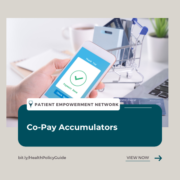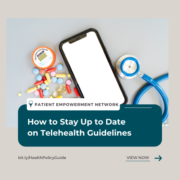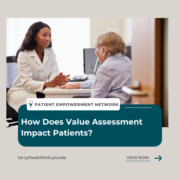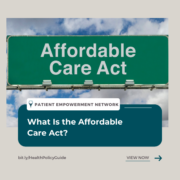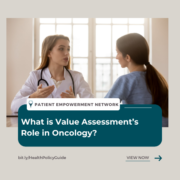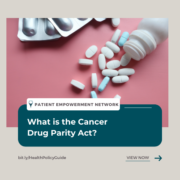Patient or Caregiver: What is My Role in Value Assessment?
Patient or Caregiver: What is My role in Value Assessment? from Patient Empowerment Network on Vimeo.
As a patient, caregiver or an advocate, how can you play a role in value assessment? Jennifer Bright, CEO of Innovation and Value shares how we can improve the space of value assessment.
See More from the Health Policy Activity Guide
Transcript
Mary Leer:
What is the role of the patient, the caregiver or the family in value assessment, and how can they improve it?
Jennifer Bright:
That is one of my favorite questions. One of the biggest parts that I feel needs to be improved in the space of value assessment, health technology assessment is the de facto involvement and presence of patient, family and caregiver perspectives. So I referenced the fact that in its simplest form, value assessment is really about understanding the clinical benefit of an intervention versus its cost, but as we know, clinical research, even today, does not capture so many of the things that patients and families and caregivers may deal with on a daily basis. It may not be representative of under-represented populations, it may not be representative of gender, how often do we hear that women are not well-represented in clinical trials, for example. So, because the clinical trial data may not represent fully represent a real population of individuals who are dealing with a certain type of cancer, for example, it automatically assess that whether the analysis of benefit versus cost is really reflective of the patient population for whom that decision is going to have an impact on what choice they have in treatment. Same goes for things like impact on family and caregivers. When we talk about cost, often when we talk about patient costs, the assumption is that we’re only talking about out-of-pocket, so co-payments or co-insurance.
But what we know, especially in the realm of cancer treatment, there are myriad financial impacts that are not captured in clinical research, that are not captured in any kind of research, but that have absolutely have germaneness to decision-making to the ability to access care and to the outcomes, because you can have the best drug in the world, but if someone can’t get to it, if it’s an infusion therapy that’s covered by their health plan, but they can’t get to the infusion center on a consistent basis, then we are spending money on things that don’t match up with patient family, real experience. And so that’s a big gap in this area is that we don’t have a good mechanism for measuring aspects of care that are really important to patients and families, and then incorporating that into our economic analysis, so that’s a gap. And the way we need to improve it is in two ways, one is on the side of the researchers and the decision make our community, they are obligated and need to do a much better job of bringing patient and family and caregiver perspectives to the table at the front end of doing value assessment and health technology assessment. In other words, ask what’s important, what are the questions, what are the treatment options, what are the trade-offs those communities are dealing with in real time, and how do we measure the value to those needs? And then when we think about how can patients and families and caregivers improve like what’s the active role of the patient community, it’s being educated about this field, driving and asking for their participation, making sure that patients and families understand is the data that’s represented in this value assessment that says, this drug is better than this drug from a cost-effectiveness standpoint, ask the question, Does this reflect my experience? Does this reflect my community? Does this research look like me and my experience in care? And if the answer is no, speak loudly and to be under place at the table, and I think that that’s an advocacy at its core, but I think that change will come when both things happen, it can’t be an either or, there has to be changed from the research pipeline and the decision-maker side, and there has to be kind of that grassroots stand up and say, This is not a good decision because it doesn’t reflect real experience.

